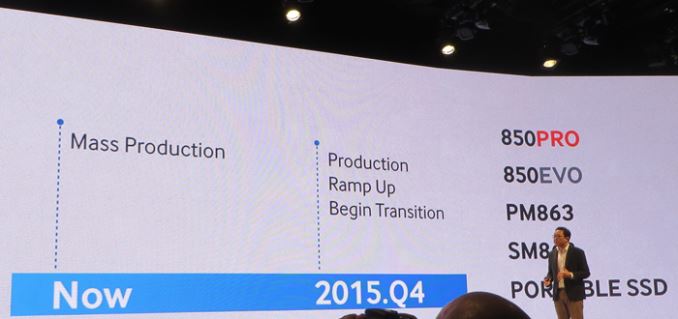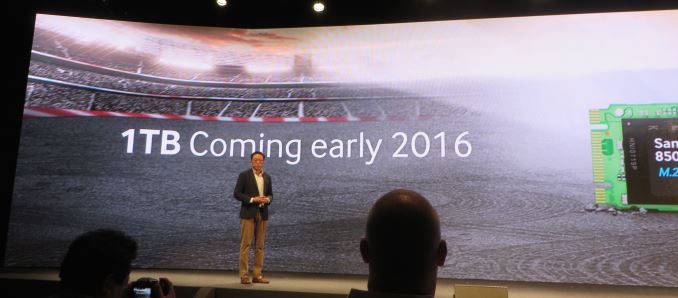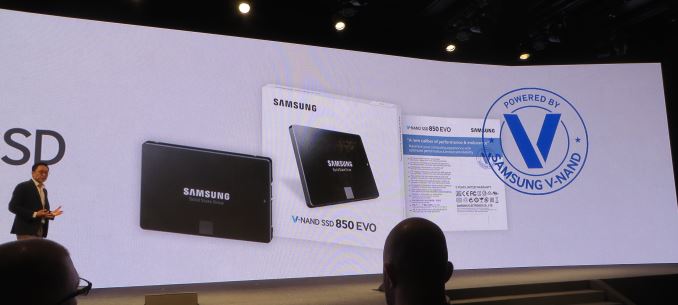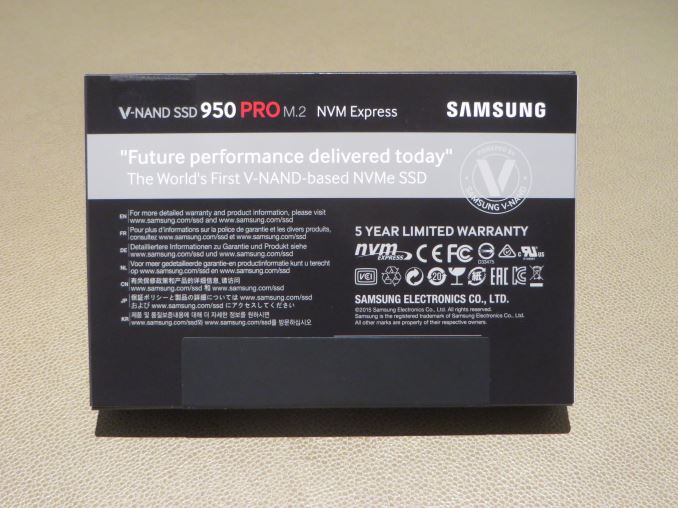Samsung Details 3rd Gen V-NAND Rollout: 4TB 850 Pro, 1TB 850 EVO M.2, & More In 2016
by Ryan Smith & Billy Tallis on September 22, 2015 5:00 AM EST
Along with announcing the new 2nd generation V-NAND based 950 Pro SSD, Samsung also detailed some of their plans for the rollout of drives based on their recently announced 48-layer 3rd generation V-NAND. The NAND, now in mass production, will begin showing up in drives in 2016.
Among the first uses of 256Gbit 3rd gen V-NAND will be to expand the capacity of Samsung’s current product lineups. The 850 lineup, which Samsung will continue to produce as their leading 2.5” SATA SSD, recently received a boost from 1TB to 2TB. Come next year, Samsung will be transitioning the 850 Pro lineup from 2nd gen to 3rd gen V-NAND, and in the process releasing a 4TB 850 Pro.
The release of a 4TB drive based around the new V-NAND was expected, but the fact that it’s under the 850 Pro lineup is a bit of a surprise. Citing the potential for consumer confusion and fragmentation, Samsung would prefer to release these drives under their existing and very popular 850 brand then to set out on a new brand for what’s ultimately going to be a dead end in consumer SSD technology. The switch to denser NAND is going to have a performance impact – such a thing is unavoidable – but it remains to be seen what that impact will be, especially given the limits of the SATA interface. To balance this out, Samsung says they will be providing more information on the drives themselves, which may be their new V-NAND branding program (more on that in a second).
Meanwhile the M.2 850 EVO, which currently tops out at 512GB, will be getting its own upgrade to 1TB via 3rd generation TLC V-NAND. Samsung has not announced any other EVO drives getting 3rd gen V-NAND at this time, though at this point it seems like a matter of when, not if.
Speaking of M.2, the newly announced 950 Pro will also get a capacity bump in 2016. A 1TB model will be released next year, utilizing the 256Gbit V-NAND MLC to double the capacity of the drive.
Samsung has also reiterated their development plans for enterprise V-NAND drives, though as usual they are being a bit less precise in discussing their plans. The PM1725, Samsung’s PCIe card SSD, will be utilizing 3rd gen V-NAND, combining 8 lanes to offer what is expected to be 1 million read IOPS.
As for Samsung’s existing Enterprise drives, the 863 datacenter drive family will also be getting the 3rd gen V-NAND upgrade. Though Samsung has not announced any specific capacities, we’d expect both of these drives to be doubled, increasing the PM863 to 7.68TB and the SM863 to 3.84TB.
Finally, as part of the launch of the 3rd generation V-NAND, Samsung will also start to use V-NAND visibly in their product branding. Consumer and enterprise retail drives will have a V-NAND logo, indicating what drives pack the technology and Samsung believe will help their drives stand apart from the competition. For Samsung this is also a reflection of the work they’ve put into developing what’s now three generations of 3D NAND, with that effort being made more obvious to buyers.















23 Comments
View All Comments
Shadow7037932 - Tuesday, September 22, 2015 - link
Man, Samsung is marching forward with their VNAND while others seem to be stagnating quite a bit. Not only that, the prices for the 850 drives have been coming down pretty fast, possibly due to Samsung getting good yields on their VNAND.SmashingTool - Tuesday, September 22, 2015 - link
Have they been coming down? I bought an 850 Evo for $340 on March 31st. It's $343 today. That's nearly 6 months with no drop on that model.SmashingTool - Tuesday, September 22, 2015 - link
1TB Model, obviously.Mondozai - Tuesday, September 22, 2015 - link
I've been tracking the 500 GB model and it came down a lot in price in H1 of this year. Since mid-summer it has kind of plateaued. The BX100 can be gotten for 140 dollars equivalent here in Sweden(counting VAT, exchange rate noise etc). The 850 EVO is at 170 or so.By 2016, we will see a mad rush to V-NAND by all the major actors in the SSD space. I'm kind of curious about NVMe. Does it have as big of an effect as going from HDD to SSD? Not really, right? But do people see significant increases in how fast programs boot up or maps load in games etc? Because I'm seeing 5X increases compared to 850 EVO yet I wonder what the real world increase is in daily use.
camelNotation - Wednesday, September 23, 2015 - link
NVMe lowers the protocol overhead, improving latency and random performance. You can search for comparisons between SM951 AHCI and SM951 NVMe to see what improvements you can expect. The improvement from AHCI to NVME definitely is not as big improvement as from HDD to SATA SSD.Kutark - Wednesday, September 30, 2015 - link
Honestly i was looking into the NVME solutions for a new skylake build im planning, and if im being realistic with myself, its just not worth the extra cost. If i were a professional doing disk intensive stuff like video editing, or whatever, it would be worth it. But, i'm primarily a gamer, and that would amount to basically an unnoticeable difference for my usage. I'm actually not even sure an m.2 pcix is worth it over a sata drive.Never the less, just some thoughts.
svan1971 - Monday, February 15, 2016 - link
the difference is $60 dollars between 850 256 and 950 256. The 950 is nearly 4x faster. Using your logic why did you buy Skylake over Hasewell which equals higher priced board, processor and memory for a 5-8% increase in speed?dgingeri - Wednesday, September 23, 2015 - link
I bought a 512GB 850 Pro last December for $339. It's now $231. I'd call that a drop.Impulses - Tuesday, September 22, 2015 - link
I bought one for $340 around August and a second one for $310 last month... Seems it's the frequency of sales that has increased much more so than a major price drop, still, the same drive was over $450 last year. Seems to take a couple years to see any major shift in SSD pricing tho, it's not a huge yearly drop.Ewitte12 - Monday, November 30, 2015 - link
Everyone is moving to some type of 3d technology and capacities are about to go through the roof. I would expect by end of year 2016 prices will likely drop a great deal again.